
DALEKS –
Nikki WhiteHands up those who like Daleks? I thought so. To the whole two of you who don't – what are you doing here?
Daleks have been synonymous with Dr. Who almost since the start. They are probably, along with the Tardis itself ,the only things that have hardly changed physically over the years. Doctors and companions; producers and scriptwriters come and ago but Daleks go on forever. All the Doctors have met them, unlike their nearest rivals the Cybermen (I don't count Jon Pertwee's run-in with the latter in "The Five Doctors" special).
Despite poor scripts particularly in the eighties, despite a certain over-familiarity, the Daleks retain their popularity. Whenever a Doctor needs establishing or his popularity is flagging, it’s Daleks to the rescue. Some Doctors notably Jon Pertwee, despise them as tinny and unconvincing - perhaps, one wonders, W.C.Fields should have cautioned about acting with children, dogs and Daleks
Why Daleks? Well, Daleks are reliable. You know they're out to exterminate the local population/enslave the planet/conquer that part of space. There's no chance you'd mistake them for Amnesty International. They don't suddenly discover sweetness and light and become reformed characters. They don't have long, soulful soliloquies on their unhappy backgrounds. Their world is black and white. No muss, no fuss.
Daleks are readily identifiable from their pepperpot shape and electronic, staccato speech patterns (which an early reviewer once likened to a bad telephone connection) and from the throbbing electronic hum on the soundtrack when they are on screen (it is possible to follow quite easily an audiotape of such stories as Death to the Daleks even when there's no dialogue) . Some of us can remember standing on platforms of tube stations in London waiting for trains to go to school, watching other schoolchildren with arms stuck out straight in front of them, chanting 'Ex-ter-mi-nate' back in early '64 when the craze had just begun.
And who can't think of a number of persons or institutions that wouldn't benefit from a visit by a squad of Daleks? Daleks are a wish fulfilment: 'you will be exterminated' to all those who stand in our way or who annoy us. They're power trips like Servalan, Space Commander Travis, System Lord Apophis (or any other Goa’uld), or the Klingons. They do what we would like to do but the law or convention forbids us.
But I'll leave the symbolism and psychoanalyses to Dr. Tulloch and the like. What do Daleks mean to me?
I was never one of those who hid behind the sofa when they were on, nor was I like the little boy in Who’s Dr.Who who had nightmares they were lurking in the bushes outside his school (some of the schools I went to they'd have been stripped for parts within minutes - if they lurked too long!). Both age (11 going 12 when the "Dead Planet" was shown in Britain) and temperament were against it. As I remarked at a panel at a Medtrek convention in 1982, all my heroes are fascist pigs - James Kirk, Commanders Kor and Kang, Travis, Darth Vader - and Daleks.
From the moment I saw what was at the end of the long, suction-pad tipped rod that had bailed up Barbara Wright at the end of that episode, I was fascinated. Even at that age, I had started writing my own Dr. Who stories, initially simply writing up each episode, then as my imagination moved too fast for the weekly episodes, branching out into my own adventures (it would be another 10 years before I ever heard of fan fiction and fanzines). Thus I built up my own ideas of what the Daleks might be.
I think it was the design of the Dalek city that first drew me to them. It was so elegantly futuristic, reminiscent of the sort of city that had inspired me visually in such comics of the day as the Valiant, Lion and the Eagle. There had to be more to the Daleks than malevolent pepper-pots to have created something like that. Remember, too, there was even some sculpture decorating it - Ian heaved one abstract piece down the lift-shaft after some pursuing Daleks. Also ,the script allowed one to see how the Daleks saw themselves and their world. They were afraid their race would be wiped out due to the fall in the level of radiation; they believed the Thals, until they saw otherwise, were hideous mutants - admittedly much of their views were based on ignorance but this did permit one to understand they were not acting out of pure malice but out of self-preservation.
Subsequent adventures reinforced the image of Daleks as scientists, if not artists. Their inventiveness and resourcefulness made them formidable enemies, never more so than with their time machine in "The Chase" or in reinventing the machine-gun in "Death to the Daleks". The comic strips found in the Dalek Annuals of the mid-60s and in TV Century 21 further emphasised this.
I was curious about the builders of that beautiful city, about the civilisation that had existed before the Neutron War. I found the concept of the forest with its plants and animals forever frozen in stone with no sound but the soughing of a dry wind incredibly haunting. So I came up with my own ideas, especially when I found the explanation of the Daleks and Thals' origins given at the end of the first story rather unsatisfying. It seemed unlikely to me, (even after doing only one year of Biology at grammar school) that a species could go through the full cycle of perfect being-mutant-perfect being in only 500 years as in the case of the Thals. And for some reason I didn't like the idea of the Daleks being a mutant in a travel machine, either. So I came up with the idea they were robot creatures with living tissue brains, complete and autonomous, no one’s servants, the successors to the dead Dals, who had created their own civilisation. This was not unlike the idea of what the Daleks are that Terry Nation came up with a decade later in "Genesis of the Daleks". For this reason I had no trouble accepting that story, unlike a number of fans, and indeed it remains one of my favourites.
I constructed a background for the Daleks which I've used in my own stories, especially those set in the Ensovaari Empire (where the Daleks have quite a history). This included giving them ranks according to colour and function; giving them music and musical instruments; a history and so on. I also borrowed some of the less outlandish ideas from the annuals such as the Dalek language.
The Dalek language is quite interesting, once you weed out words that have been clumsily adapted from Latin or old English. It is full of terms that imply a race which venerates learning and research, such as "'Zetic’ - meaning to search and find – discovery - one of the most important words in the vocabulary of the science conscious Daleks "; or "'Tabada’ - a scholar. Daleks undergoing instructional training are called tabadas"; or "'Quirradill’ - a Dalek term of office or mark of appreciation. To be a Quirradill means to be a master of some trade or profession."
There are levels of language which, when taken with the above emphasis on learning and scholarship, gives the Dalek language a somewhat Oriental quality. For example to prefix a word with the letter 'J' is a form of disrespect (qv "su..." or "gu" in Japanese) while to prefix with "Z" is a sign of especial esteem (qv "go" or "o..." or "mi ... " in Japanese). There are sayings such as "Nizzial" meaning "'The one beside you is yourself", an offer to share trouble; "Clyffl" meaning "I understand you but I do not agree with you," which hint at a richness of culture not explored in the series.
Some other improvements I made to the Daleks of my universe were the addition of aritigravs built into the body of the Dalek which could be activated as required (this was long before the jokes about Daleks and stairs) to enable the Dalek to ascend - and descend - steep heights and depths. And there is a sensor grid all over the Dalek's body (what those round things are on it) so they can detect the approach of anything from all angles. You can't sneak up on these Daleks! Since they were beings in their own right, they had names such as Symenarlek, a Dalek Supreme (i.e. one of the Council of Twelve, right below the Emperor in my universe) one of the most decorated beings in the Ensovaari Empire; Menalek,a Black Dalek (who had a close encounter with the Klingon Kor and violated its conditioning to kill a renegade Ensovaari scientist – and paid the price); Tetralek, a Blue Dalek (who had the human factor, from James T. Kirk, put in to it with bizarre results), and so on.
Like a lot of other people, I used to doodle Daleks in my notebooks at school (along with ninja) and lecture-pads at university. Christmas of 1965 I wanted a friction Dalek that was on sale in a shop in Lakemba for the princely sum of 8/-. I think I got a bottle of 4711 cologne instead. I finally did buy such a Dalek (around 1976/77 through a friend in England). At University I was the only person with a Dalek pin-up on the wall of her room and when I started work, I made a Dalek out of balsa wood and fibre-glass in a scaled down version (30cm) of the plans given in the Radio Times Dr. Who special of 1973.
The ‘Dalek Army’ (consisting of various Daleks from the 1970s to the present in all shapes and colours (including a bubble bath one) now resides in the lounge room and not the spare room because if there is one creature in the universe which can overpower and destroy Daleks with little effort it is one of these

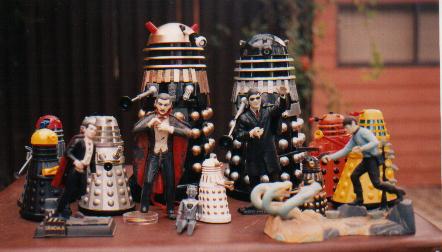
The Dalek Army (with some interlopers) ca. 1988.
The small animal fancy had another deleterious effect on my interest in Dr. Who and the Daleks. I was a subscriber to the Dr. Who Magazine (Weekly, Monthly) from the first issue until #317 (28 May 2002). The reason? I was also (and still am) subscribing to Fur & Feather and I couldn’t afford both..
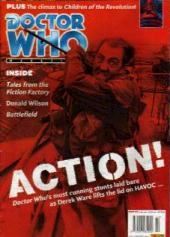
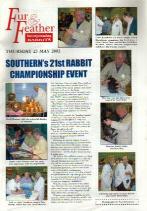
It was either this Or this
They now look like this and this
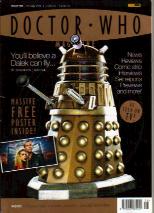

Even so, the cavy breeder in me is inclined to describe the Cult of Skaro as consisting of a Self Black and three Satin Buffs.
Among robots/cyborgs ,Daleks still reign supreme and are a welcome relief after the excessive cuteness and sweetness of robots like R2D2,C3PO,Twiki, even K9 - I like a robot that's never heard of Asimov. The Cylons of the original Battlestar Galactica and the Borg can't hold a candle to them. Even more than the Daleks, the Cylons and the Borg suffered from 'scriptwriter-itis'. They were 'humanised while the Daleks have remained alien. Too, the Cylons couldn't shoot straight. But against anyone but the Doctor and his mates, the Daleks are chained death.
Scripting and stories have been a problem for the Daleks in the post-Genesis era and have damaged their credibility somewhat. Consistency between Dalek stories was always a problem, leading some of us to speculate parallel universes were involved e.g. there's one where the Daleks were conquered by the Moroks, one (perhaps the same one) where the Daleks are a dying race confined to their city, beings mutated by radiation and mobile only through travel machines, and so on.
The format of a typical Dalek story is fairly predictable, though nonetheless effective. It is not until the tail end of the first episode that they make their first appearance (usually as the end credits roll), after a careful build up (I recall this technique being used as far back as "Dalek Invasion of Earth" and irate mothers writing into the daily papers complaining that children went under protest from the TV set, all bitterly disappointed that after waiting so long for the return of the Daleks, there were none to speak of in the first episode). A notable exception to this is Resurrection of the Daleks where they appear part way through the first episode.
There should be a feeling of tension, even when they are not on screen and despite their familiarity (by now). Daleks can be unpredictable. They don't always shoot first, sometimes they keep people alive and use them, sometimes they ignore them if they are no threat. The Daleks' scientific ingenuity must be stressed. They should not be seen as stupid, or made fun of - it is a bad mistake for the Doctor or other characters to make jokes about Daleks' supposed inability to go upstairs. This sort of design fault should be concealed, not played up, though in Revelation both Daleks and Davros were seen to hover briefly and of course, both Remembrance and Dalek amply demonstrated this stair problem to be a furphy. Even before that, they were seen on upper floors or at the top of flights of stairs, the implication being they must have got there somehow. Such vulnerability, such weakness of design such as being earthed by a rubber Thal cloak or having mud stuck on the eye-stick by someone creeping up behind worked well enough in the first story because they were a dying race confined to their city. They do not look convincing in a hi-tech conquering race with a star-spanning empire.
Once the Doctor and other characters do not take the Daleks seriously, then neither can we, the viewers. Theirs is a simple but effective design but it is not inherently menacing, so it needs a build up for credibility. True, it is non-anthropomorphic and lacks a 'face', but in these days of R2D2, this alone does not guarantee threat. The recent revamp has endowed them with a solid, heavy-looking, industrial quality and a no-nonsense bronze look. They appear to be slightly taller and the bulbs on their heads are longer like those in the movie Daleks. These all give them a certain gravitas. You don’t mess with these Daleks.
The best stories are those that give credit where credit is due and acknowledge the threat and scientific genius of the Daleks. This is why I rate "Dead Planet", "Dalek Invasion of Earth", "Daleks’ Masterplan", "Power of the Daleks", "Evil of the Daleks", "Planet of the Daleks", "Death to the Daleks" and "Resurrection of the Daleks all highly of those I have seen or heard via BBC CD audio ("Daleks’ Masterplan" not having been shown in Australia). "Genesis" was also excellent but for other reasons. The focus was on Davros, thus beginning the shift of the Daleks from centre stage and having them rely on Davros, thus weakening their power and their menace. ("Resurrection" also had something of this but restored to the Daleks much of their dignity as a formidable foe.). "Dalek" and "Bad Wolf/Parting of the Ways" mercifully had not even a mention of Davros and fully restored Daleks to how we remember them from the 1960s – independent, thinking, manipulative and devious with real personalities.
This what I said in a recent issue of Centero after seeing "Dalek". "The look is subtly updated and is impressive. They have been returned to centre stage as characters in their own right and not Davros’s running dogs. Thanks goodness the new team don’t believe JNT’s dictum shared by some of his era’s scriptwriters that no one wants to hear much dialogue from Daleks as they are ‘boring conversationalists’. This is a return to their glory days when they could and did carry much expository dialogue. The aforementioned two-hander between the Doctor and the lone Dalek effectively nailed that JNT furphy. In this and the following sequences, we have a Dalek not only speaking a lot of dialogue but expressing a range of emotions and matching the Doctor every step of the way, alternating between anger, fear, hurt, bewilderment and frustration. Pity JNT is no longer with us. I’d have liked to have tied him to a chair and made him watch that. Now that the Daleks have been unmuzzled and are out of Davros’s shadow, let’s hope they stay that way.
"The Daleks’ capabilities are spelled out. We see bullets fail to penetrate the Dalek’s shielding. We see how deadly they are in battle with the centre of the body spinning around to blaze away behind, giving it a 360 degree field of fire and at great speed. The Dalek death ray effect has been further enhanced from Remembrance of the Daleks. It is not only blue but the skeleton of the victim is outlined in black making for a fearsome effect and underlining just how lethal the fire is. Also following on from Remembrance is the Daleks’ ability to ascend stairs. The effect is similar but shows the advances made in CGI in the past 15 years. Now you can believe a Dalek can really fly. We see it hovering above the soldiers directing fire on them (in a cunning bit of tactics involving using the sprinklers to electrocute those on the ground while it deals with those on the walkways). One other influence of Remembrance is that the Doctor attempts to talk a lone Dalek into suicide.
"The genius of the Daleks, which was often mentioned with begrudging admiration by the Doctor and others, pre-Genesis, is brought to the fore when the Dalek takes just a minute to go through a billion combinations to unlock a door. However, one does wonder about the state of its brain when it downloads the entire internet. Never mind how many thousands of terabytes that would be (the National Library’s Whole of Domain harvesting, which just captured only those websites with a ‘.au’ extension, netted 6.7 terabytes of uncompressed data), just think of the mental indigestion of the juxtaposition of the research in academic repositories, the contents of libraries and museums all jumbled up with what Kylie Minogue had for breakfast, all those porno sites and the results of Big Brother! No wonder suicide seems like an option. After all, when the Doctor told it to kill itself, the Dalek more or less told him to stick it in his ear. However, later, it asks Rose to give it the order to self-destruct. So what had changed? The dreaded human factor (Rose’s DNA) and the internet.
"The episode raised questions about identity. What are you if all you are a part of, all the infrastructure that makes you, you is gone? Both the Dalek and the Doctor are the last of their races. Both are survivors of a catastrophic war, both by accident. The Doctor has his zest for life and exploration. The Dalek, bred and trained as a soldier, to kill and to defend the Dalek race, has nothing, no other resources to fall back on. However, despite their differences, there are moments of similarity which the Dalek (and later Rose) recognises. At times, the Doctor with his rage at and disgust with the Dalek race acts like a Dalek, ruthlessly seeking to destroy his enemy. "You would have made a good Dalek," the Dalek says. From a human this would have been an insult but from a Dalek it is a complement. This pulls the Doctor up at least for a while. We can see that it is a very deep-seated fear of the Daleks, a recognition of their very real threat, that makes him act in an almost hysterical and ruthless manner. This Dalek also knows which buttons to push, too. Later, the Doctor takes a large weapon to the Dalek and tells Rose to get out of the way. She refuses. He tells her what dreadful creatures Daleks are and she replies simply, "But it isn’t the one pointing a gun at me."
"From one point of view, the Dalek’s actions are not particularly appalling, It had been tortured for some time and kept confined. Soldiers were sent against it and it acted in self-defence. True, the body count was very high but since Van Statten kept throwing his men at it, wanting it undamaged in his desire to posses it, the billionaire was as much to blame. Indeed, the Doctor compared Van Statten unfavourably with the Dalek. In the end, the Dalek showed more humanity but Van Statten, the symbol of the ruthless billionaire businessman concerned for his collection and his profits, never did. Incidentally, the name he came up for the Dalek, ‘metallatron’ was so 1960s Terry Nation."
"Day" was too slow and static. The Daleks stood around like pepper-pots and seemed a tad hysterical and ineffective. Daleks should be in motion all the time, as if building up too much nervous energy, rocking back and forth or pacing. Long speeches in close-up are fine (contrary to what some of the 80s production team thought) as long as the Daleks have something interesting to say and are shot imaginatively. The new design certainly can withstand extreme close-ups. In fact extreme close-ups used to be quite common in the 60s Dalek stories, especially the first one where the Daleks’ eyes had expanding and contracting irises. Bulbs on their 'heads' should light up so you know which one is speaking, the eyestick should move to give added visual interest (there were some nice point-of-view shots in "Death to the Daleks", "Remembrance of the Daleks" and "Dalek" to add variety).
In "Day" the Daleks relied on the oafish Ogrons who'd get lost in a revolving door.
"Destiny of the Daleks" completely trivialised them - at the mercy of some shop-window dummies, ineffectual, cheap-looking, shoddy and stuck in a BBC quarry (again) ,mocked and made fun of by the Doctor, a nadir of their screen in history.
"Revelation" was a lot of fun, a pastiche of Waugh’s The Loved One with lots happening on and off screen and at subtext level. However, it wasn’t really a Dalek story so much as a Davros showcase. The Daleks were very much second fiddle to Davros so there was an imbalance. No longer the cosmic menaces, they were his rather sinister versions of K9. Though we were left with the tantalising image when the 'real' Daleks turned up from Skaro, where we learn that the Daleks now go in for trials (I could just see a Red Dalek in a full-bottom wig up on the bench while Rumpole Dalek, in French wig and gown, pleaded Davros' case before him/it. An image the 1996 Dr. Who movie re-enforced but with the Master instead of Davros. What is Skaro? An intergalactic Old Bailey?)
Daleks have featured in 17 stories (18 if you count the cameo in The Five Doctors special) to date and two feature films, as well as three plays. It is significant it was their stories which were turned into films, I think. The Dalek craze of the mid-60s spawned Dalek masks, Dalek playsuits (these were on offer as a prize for giving a name to a Dalek run by a London newspaper around Christmas 1964 I recall), Dalek stencil sets, Dalek wallpaper, Dalek slippers, Dalek construction sets, Dalek painting-by-numbers, Dalek stand-up inflatables (and you can still get inflatable Daleks today – sounds a bit like something you’d get in one of those shops in Fyshwick. Kinky, much?), chocolate Daleks, Daleks writing pads and greeting cards, cigarette sweets which included illustrated cards in each pack which had a Dalek story on them, similar to the type seen in TV Century 21 comic, battery-operated Daleks, friction-powered Daleks, Dalek bagatelle sets, The Daleks, an EP issued by Century 21 records in 1966, running 21 minutes of the last episode of "The Chase" ,featuring Daleks and Mecharioids, the annuals The Dalek Book, The Dalek World, and The Dalek Outer Space Book which contained information about Daleks, as well as The Dalek Pocketbook. There were many more things. These are just those I remember.You can check Howe’s Transcendental Toy Box (Telos, 2003) if you are really interested.
There was a brief resurgence of Dalekmania in the 70s with Dalek Annuals being published for the years 1976,1977,1978 and 1979 and Doctor Who and the Daleks Omnibus which reprinted material from the 60s annuals, summaries of then recent Dalek TV stories and had some good colour plates. The BBC Radio Times special celebrating 10 years of Dr. Who in 1973 featured an original story about them by Terry Nation as well as plans on how to build a full-size one. Daleks also featured on one of the three jigsaws of Jon Pertwee's Doctor issued around the same time and in a Tom Baker one. There was the Dalek Death-Ray ice-block (chocolate and peppermint, well brown and green, as I recall. I had one when I was in London on holiday in Feb. 1976. Not a time I usually eat ice-creams, winter). The battery-powered Louis Marx Daleks were reissued around 1975, followed by the reissue of the friction Dalek. Also in the mid-70s the boardgame, "War of the Daleks" with miniature Dalek playing pieces came out. "Genesis of the Daleks" was released on LP as an audio play.
The 80s were not very kind to the Daleks, except for a brief shining hour in "Resurrection" and "Remembrance". I had hoped Davros, who had been a millstone to them in recent years, might finally have been killed off and at their behest as would be appropriate, but not with old Recycle-'em Nathan Turner on the job. Davros had more farewells than Nellie Melba and more revivals than the Daylight Saving Bill (before it was finally introduced in the early 70s,of course).
By 1987 (when this was first written) their future appeared as uncertain as the program’s. I expressed the hope that "in their next story - and that is one thing we can be sure of, there will be a next Dalek story - they are treated with a bit of respect and a bit of imagination. And hopefully, this outing they'll leave Davros in the Goodwin Retirement Village." I got my wish with the magnificent "Dalek" in the new series where they were returned to all their glory, capable of doing the things we could only imagine or see realised in the old comics. Capable, too, of a range of emotions, and of being every bit as devious and manipulative as they had been in the 1960s. And no Davros in sight!
(Revised version of an article originally published in Dodecahedron #2 (June 1987))
FOUR DECADES OF DALEKS
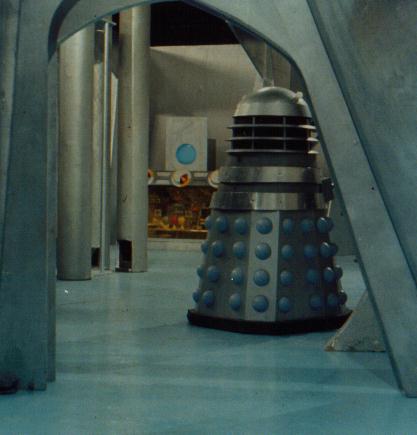
1963
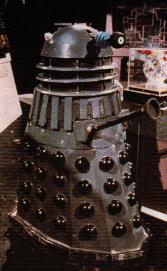
1973
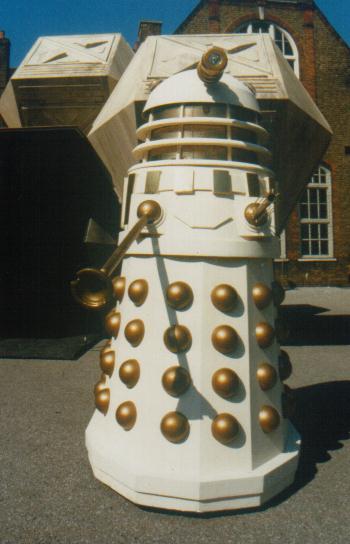
1988

2005
(Dalek images copyright BBC and Terry Nation)